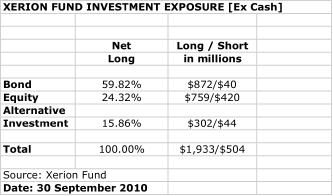
Categories
Resource Links
 GIR's Investing in the New Europe
GIR's Investing in the New EuropeBloomberg Press, 2001, "Sound, practical advice."
Wall Street Journal Europe
XERION FUND: TRADING PLACES
15 October 2010, Barron’s
Soon after the Berlin Wall fell in 1989, Daniel Arbess, as a young associate at the international law firm White & Case, booked a seat next to the Czech Minister of Economy on a flight back to the states to make a mid-air case for helping the fledgling democracy shift from a state-driven to a market economy. The trip paid off. The Czech government appointed Arbess and White & Case as its privatization adviser.
Ever since the mid 1980s, Arbess saw the coming rebalancing of global economic power as reforms began in the Communist world. He has devoted his career to participating in this transformation. And the time Arbess spent in Eastern Europe during the 1990s gave him insight into the opportunities offered by systemic economic reform.
To better participate in the process, Arbess made his own adjustment, from advising to investing. He launched his New York-based Xerion Fund to do just that. And its performance has borne out his optimism.
Since its inception in 2003, the fund’s annualized gains have topped 18% through September. The only year he lost money was in 2005, when the fund was off less than 1%. In 2008, when hedge funds lost nearly one-quarter of their worth, Xerion was up 31 basis points. Over the past five years when the average hedge fund gained 5.34% a year, Xerion earned more than 16%. And Xerion ranked 18th in Barron’s recent top 100 hedge fund survey.
To Arbess, who’s 49, the rise of emerging markets and their billions of consumers is “a generational avatar of investment opportunity,” driving capital and growth away from over-leveraged uncompetitive businesses in the West toward companies investing and operating in Asia and other emerging markets. His strategy is based on contraction of Western markets, weighed down by broken balance sheets, and expanding Eastern economies, buoyed by strengthening financials.
When investing in developed markets, he and his 12 analysts often move up the capital structure, buying distressed paper and bonds in heavily indebted Western companies. They also like some equities emerging from bankruptcy with cleaned-up balance sheets. Sometimes, he invests in both debt and equity of the same company at different times.
Back in 2004 as a distressed debt investor, Arbess played an activist role in shaping the St. Louis-based chemical maker Solutia’s trip through bankruptcy. The following year, he sold of the bonds at twice his cost. But he continued to track the company, maintaining close ties with management.
He saw a new opportunity at the nadir of the credit crisis in 2008 when Solutia’s senior secured bank debt traded down from par to 63. Sensing significant mispricing, Arbess loaded up on these loans at an average cost of 71. Within a few months, Xerion sold out near par.
Solutia’s stock had also collapsed at the same time, falling from $21 to nearly $1. In addition to a broad market collapse, Arbess thought the stock was also being dragged down by major hedge fund shareholders who bailed to meet redemptions. But he saw a solid company shedding unprofitable lines, re-focusing on core businesses, and expanding rapidly into emerging markets. He started buying shares as the stock broke above $6. The fund is now one of Solutia’s ten largest shareholders, and in early October, its shares were trading near $17.
In spring 2006, consistent with his long-term belief in hard assets, Arbess began accumulating shares in Canadian copper and gold mining company Ivanhoe Mines [NYSE: IVN]. He was intrigued by firm’s primary resource: Oyu Tolgoi, the world’s largest undeveloped copper and gold mine located in Mongolia.
Mining companies in the development stage trade at steep discounts to their earnings potential because of financing and operating risks. Ivanhoe was also being affected by political uncertainty of how the newly democratic government of Mongolia would respond to a find whose estimated worth is in the tens of billions of dollars.
When he first started investing around $5 a share, Arbess thought the miner was trading at a 90% discount to its potential value. Just several months later, his investment appeared to be substantially derisked when Australian resource giant Rio Tinto invested over $1 billion at $10.35 a share and took over project management.
However, shares then languished for two years as royalty and tax negotiations with the government dragged on. When the economic crisis hit, they collapsed back into the low single digits. But Xerion held firm and doubled its position. The stock broke again into double digits in the summer of 2009 as the market began to stabilize.
In October 2009, with the company having reached an agreement with the government, Ivanhoe took off, trading above $24 this past September. Now worth over $140 million, the miner is Xerion’s largest equity position, and Arbess sees Rio Tinto’s battles for control likely to send shares even higher.
Newspapers are not on most investors’ “Buy” lists. But Arbess found another unique opportunity in Canada’s second leading newspaper publisher, Canwest LP, a wholly-owned subsidiary of Canadian Media. “After the failure of Tribune in the fall of 2008, markets were lumping all newspapers in the same troubled category,” recalls Arbess. “But this was a mistake.”
During the worst of the financial crisis, the Canadian economy was in much better shape than the US. The banking industry remained sound. Ad revenue held up. Internet is less threatening, Canadian papers enjoy strong readership allegiance, and there is also less print competition up north.
To Arbess, the problem—and opportunity–arose when Canwest was unable to refinance $1 billion in senior secured bank debt as credit underwriting dried up and investors further soured on the industry.
Despite the likelihood of bankruptcy, Arbess found value in the company’s deeply discounted bank debt. In November 2009, he started amassing a position in the high 70s. Xerion ended up holding 10% of Canwest’s senior bank debt. Arbess and his partner Victor Consoli joined the steering committee of lenders and played an active role in a negotiated bankruptcy.
Xerion saw a franchise capable of supporting continued operations and the company’s bank debt. A court-ordered test produced a financing solution that ensured repayment of senior bank debt holders at par. This occurred, and Xerion was out by summer.
Earlier this year, Arbess saw two economies heading in opposite directions: an overleveraged, fiscally-challenged Japan and resource-rich, fiscally-sound Canada. He saw an opportunistic trade shorting the Yen against the Loonie. So he established a position in early spring in the mid ¥80 per Canadian dollar, with a target of ¥100. By late April, the cross-rate broke ¥94. But it has since retreated below Xerion’s cost and in early October was trading at ¥82.
Arbess believes the trade is being hurt by G-20 countries jockeying for competitive export advantage through currency devaluation. In particular, he believes China has been buying the Yen, hoping to push Japanese export prices higher. And it has been working, despite Japanese Central Bank attempts to temper its soaring currency.
In not wanting to get caught in a central bank crossfire, Arbess decided to close out the trade at a slight loss. But long term, he believes the trade is more compelling than ever.
Minimizing losses are a key to Xerion’s strategy. The fund accomplishes this by correlating investment size with risk. Arbess doesn’t rely on leverage for performance, And he maintains healthy cash balances [presently 33%] to move on trades and meet redemptions, if necessary, without needing to sellout of positions before he wants to.
While many managers are waiting for recovery to finally catch, Arbess is not holding his breath. While he sees pockets of value across developed markets, he thinks the present state of affairs is the future, and the fundamentals are telling him that distressed situations in the west and emerging market equity growth in the east—especially in China—are where investors should be.
Tags: Argonaut, Balestra Capital, Barnegat Fund, China, Closed-end funds, Commodity Trading Advisors, Emerging Markets, Europe, Finance, Finisterre, Global macro, Government Policy, Hedge funds, mutual funds, Partners, Recession, Recovery, Risk management, Xerion Fund
This entry was posted on Sunday, October 10th, 2010 at 11:17 am and is filed under FUNDS, INTERVIEWS/PROFILES. You can follow any responses to this entry through the RSS 2.0 feed. You can leave a response, or trackback from your own site.
Leave a Reply
Search
Opalesque Interview of Eric Uhlfelder







